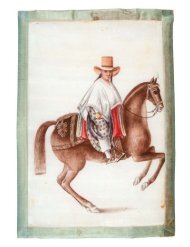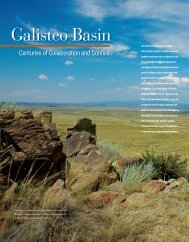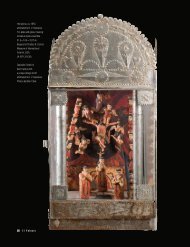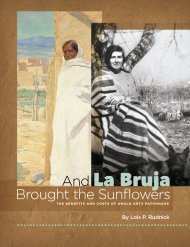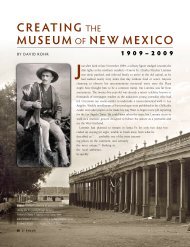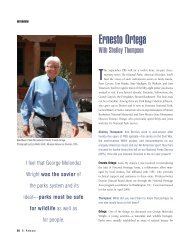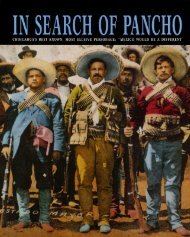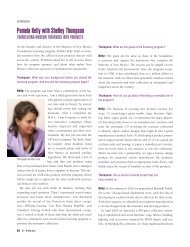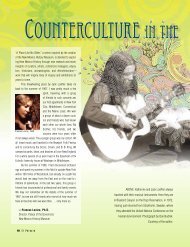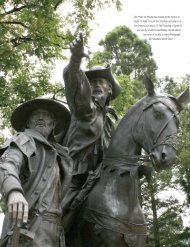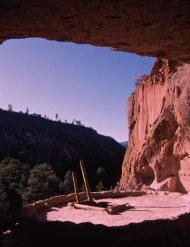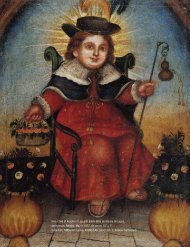Secrets of Casas Grandes - El Palacio Magazine
Secrets of Casas Grandes - El Palacio Magazine
Secrets of Casas Grandes - El Palacio Magazine
- No tags were found...
You also want an ePaper? Increase the reach of your titles
YUMPU automatically turns print PDFs into web optimized ePapers that Google loves.
secrets <strong>of</strong> casas grandesBELOW: Ramos Polychrome male smokereffigy jar, <strong>Casas</strong> <strong>Grandes</strong>, a.d. 1200–1450.Collection <strong>of</strong> Alan S. and Alice B. Fleischer.ABOVE: Ramos Polychrome olla with stylized macaws, <strong>Casas</strong> <strong>Grandes</strong>,a.d. 1200–1450. Collection <strong>of</strong> the Amerind Foundation, Inc., Dragoon, Arizona, 4605.<strong>Casas</strong> <strong>Grandes</strong>. He believed Paquimé was the outpost <strong>of</strong> aMesoamerican state where merchant rulers exploited localresources and controlled the exchange <strong>of</strong> shell, ceramics, copper,and turquoise, all channeled to classic Mesoamerica.Today there is little accepted evidence to support amodel <strong>of</strong> direct Mesoamerican intervention. However, DiPeso’s fascinating work still tells us much about the people<strong>of</strong> Paquimé. The great pueblo was the home <strong>of</strong> potters,stone workers, craft specialists, weavers, ball players,macaw breeders, hunters and farmers, traders, religiousleaders, and families. The city was densely populated withthree to five thousand people.Visitors to Paquimé immediately notice thick-walledadobe roomblocks, some with unusual cross and butterflyshapes. Paquimé contained about two thousand rooms.Setting it apart from other Southwestern sites, a ceremonialprecinct includes ballcourts, a colonnaded gallery, anelite tomb complex, and seven massive platform mounds.Archaeologists Michael Whalen and Paul Minnis characterizethe imposing, substantial nature <strong>of</strong> the buildings as architecture<strong>of</strong> power, designed to awe visitors to Paquimé eighthundred years ago, much as it does today.The control <strong>of</strong> water was an integral feature, with a sophisticatedwater system linking domestic reservoirs to a spring.There was an underground well, and stone-lined canals suppliedwater and drained refuse. In surrounding areas, irrigationditches directed water for the farming <strong>of</strong> corn, beans, andsquash, a diet supplemented by the hunting <strong>of</strong> game.<strong>Casas</strong> <strong>Grandes</strong> is the only area <strong>of</strong> the Southwest withevidence <strong>of</strong> macaw breeding. Nesting pens with heavy entrystone rings protected caretakers from the sharp beaks andclaws <strong>of</strong> the birds. Several hundred macaw skeletons, alongwith eggshells, are evidence <strong>of</strong> breeding. Scarlet macaws(Ara macao) are not native to <strong>Casas</strong> <strong>Grandes</strong>. Their naturalhabitat is tropical lowland areas such as Veracruz. Macawswere raised for trade in feathers, or less commonly for export<strong>of</strong> the birds themselves. Macaws were prized for their brilliantfeathers, used in ceremonies. Most macaws found incontemporaneous archaeological contexts in the Southwestprobably came from <strong>Casas</strong> <strong>Grandes</strong>. Macaws appear on <strong>Casas</strong><strong>Grandes</strong> pottery in realistic and stylized designs, emphasizingtheir great cultural significance.<strong>El</strong> <strong>Palacio</strong> 35



